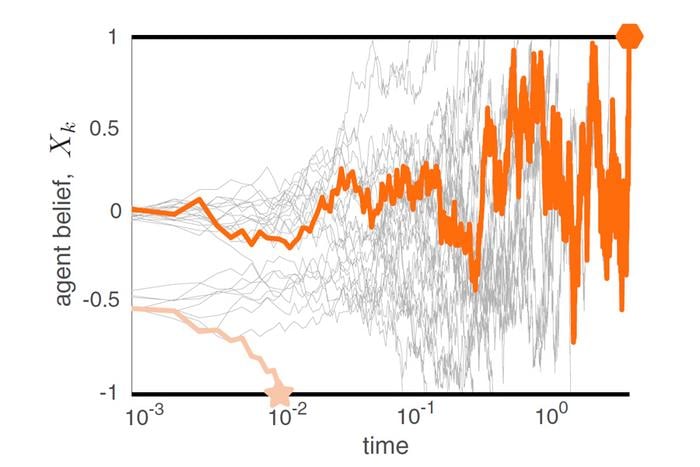A team of researchers has developed a mathematical framework that explains how initial biases and additional information shape the decision-making process. The study, published in Physical Review E, offers insights into group dynamics and individual choices.
The Mathematics Behind Quick vs. Slow Decisions
The research, led by Florida State University’s Bhargav Karamched, demonstrates that rapid decisions are more susceptible to initial biases. Conversely, decisions made after gathering more information tend to be less biased.
Karamched, an assistant professor in FSU’s Department of Mathematics and the Institute of Molecular Biophysics, explains: “The basic result might seem sort of intuitive, but the mathematics we had to employ to prove this was really non-trivial.” He adds, “We saw that for the first decider in a group, the trajectory of their belief is almost a straight line. The last decider hovers around, going back and forth for a while before making a decision.”
The team’s mathematical model represents a group of agents choosing between two options – one correct and one incorrect. Assuming rational behavior, the model shows that even with evidence, bias can lead early deciders to make the wrong choice 50% of the time. However, as more information is gathered, the likelihood of arriving at the correct conclusion increases.
Real-World Applications and Future Research
While the model assumes perfect rationality, real-world decision-making involves numerous factors such as emotions and social influences. This research provides a benchmark for optimal rational choices, allowing future studies to compare real-world data against this metric and explore reasons for divergence.
The model, known as a drift diffusion model, combines two concepts:
1. Drift: An individual’s tendency to move towards an outcome based on evidence
2. Diffusion: The random variability of the presented information
This framework has potential applications in various fields:
– Understanding group dynamics and the influence of early decisions
– Identifying instances of groupthink
– Analyzing complex systems with multiple actors, such as the immune system or neuronal behavior
Karamched acknowledges the need for further research: “There is still a lot of work to do to understand decision making in more complicated situations, such as cases where more than two alternatives are presented as choices, but this is a good starting point.”
Why it matters: This research provides valuable insights into the decision-making process, which can be applied to various real-world scenarios. By understanding how biases and information influence choices, we can develop strategies to improve decision-making in fields such as business, politics, and healthcare.
The study’s findings could help organizations and individuals:
– Recognize the impact of initial biases on quick decisions
– Understand the value of gathering additional information before making choices
– Develop strategies to mitigate the effects of bias in group decision-making processes
– Improve the accuracy and effectiveness of decisions in complex environments
As decision-making becomes increasingly complex in our information-rich world, this mathematical framework offers a foundation for further exploration. Future research may focus on expanding the model to include more than two choices, incorporating real-world data, and developing practical applications for improving decision-making processes in various domains.
The collaborative effort involved researchers from the University of Utah, the University of Colorado, and the University of Houston, with support from the National Science Foundation and the National Institutes of Health.
If our reporting has informed or inspired you, please consider making a donation. Every contribution, no matter the size, empowers us to continue delivering accurate, engaging, and trustworthy science and medical news. Independent journalism requires time, effort, and resources—your support ensures we can keep uncovering the stories that matter most to you.
Join us in making knowledge accessible and impactful. Thank you for standing with us!

